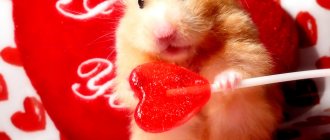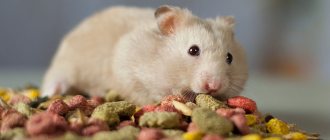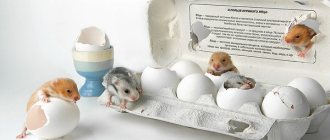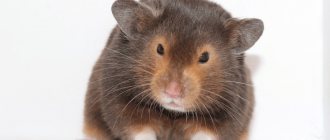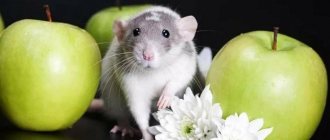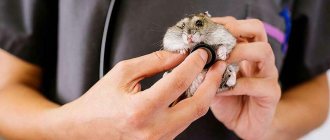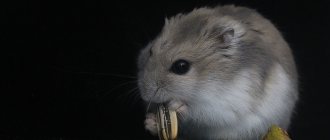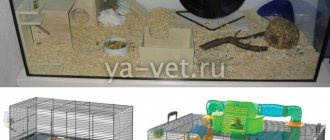The natural food of small rodents living in nature are seeds of cereal plants, legumes, berries, fresh stems and leaves, and insect larvae. Animals kept at home are forced to eat what their owner feeds them. The principle “proper nutrition is the key to health” should apply not only to people, so before getting a pet, you need to think about its diet. For example, you need to understand whether hamsters can eat seeds? In what form is it better to offer your pet a treat? There are several possible answers to these questions.
Sunflower
Sunflower seeds are a component of specialized food mixtures for rodents, because they are part of the animals' natural diet. The seeds contain beneficial substances that have a positive effect on the heart, blood vessels, and nervous system of the baby’s body. This:
- vitamins (A, E, D and group B);
- minerals (iodine, zinc, calcium, iron, etc.);
- amino acids;
- polyunsaturated fatty acids.
Therefore, the answer to the question whether it is possible to give your pet sunflower seeds will be positive. You even need to give these seeds to your hamster. But there is a limitation. Since sunflower grains contain 30% vegetable oil, they are very high in calories. It is not recommended to feed your pet them often. This will lead to health problems associated with obesity.
How many times a day to feed
Khomkis love to eat and almost never refuse a treat. But don't get carried away with excessive feeding. This is fraught with obesity and other problems associated with excess weight.
Video: feeding the Djungarian hamster It is recommended to feed the animals no more than twice a day. Since hamsters are nocturnal, their main meal should be in the evening.
The baby will spend all the energy received from food during wakefulness. In the morning you can give lighter food and in small quantities. It will be ideal if you can feed your pet at the same time. This is very useful for the full functioning of his gastrointestinal tract.
Find out more about breeding and reproducing Djungarian hamsters at home.
Pumpkin
Can hamsters have pumpkin seeds? Pumpkin seeds are also a source of valuable nutrients. A whole complex of beneficial components of these grains helps lower cholesterol levels, maintain blood composition within normal limits, and establish proper functioning of the heart and vascular system. In addition to vitamins, calcium, phosphorus, iron, copper, selenium, zinc, magnesium and potassium, pumpkin seeds contain the substance cucurbitin. It has an anthelmintic effect. Including pumpkin seeds in your baby’s diet will protect him from parasites, maintain health, and prolong life.
Pits from apples, cherries, peaches, apricots and plums
Apple seeds contain a very dangerous substance - amygdalin glycoside. The glycoside amygdalin is broken down by gastric juice and forms hydrocyanic acid. This acid is classified as a very strong poison - cyanide. One seed contains a small amount of this substance and it is not dangerous for humans. But for a small rodent this will be a lethal dose.
Cherries, peaches, apricots and plums also contain a toxic substance called cyanide in their pits. If you give your pet such a bone and he gnaws it, chews it, or otherwise damages the bone, the animal will be exposed to hydrogen cyanide.
Therefore, pits from apples, cherries, peaches, apricots and plums are strictly contraindicated for a hamster.
Melon and watermelon
What seeds are best to offer to your pet? Watermelon or melon? The seeds of both of these melons can be fed to hamsters. Melons will especially benefit pregnant females because they contain folic acid, which is necessary for the proper development of the offspring. Components such as vegetable proteins and fats are necessary to build the muscle tissue of the animal.
Watermelon seeds are rich in vitamin D, polyunsaturated fatty acids, as well as other elements necessary for a full life for an animal.
How to give water to a dzhungarik
Water is necessary for the full life of any organism, and the Djungarians are no exception (even though they originally lived in dry steppes and deserts). The fluid that your hamster gets from vegetables and fruits is sometimes not enough.
Especially in hot weather, he may experience extreme thirst. For drinking, it is better to purchase a drip drinker, so your pet will have round-the-clock access to liquid. It is better to take purified water, as boiled water or just from a tap can be too hard.
Heat-treated seeds
Roasted sunflower seeds (often salted) are often present on our table. They are easier to peel and have a more pleasant taste than raw ones. But this is for people. Can hamsters eat roasted plant seeds? Yes, but little by little. Due to the effects of heat, most of the beneficial substances were destroyed, but a lot of fat remained, which, if consumed in large quantities, will cause obesity. You cannot treat your pets to food containing salt, so fried salted seeds are contraindicated.
It is better to feed your pet raw seeds, which rodents eat in nature. This is a familiar, healthy food that is guaranteed not to cause problems with your well-being.
Do not forget that grain mixtures should make up only part of the animal’s diet, because with all the variety of useful components, they cannot provide the body with everything it needs. Be sure to feed your baby fresh grass (grown in an environmentally friendly place), pieces of vegetables, fruits, and berries.
What does a hamster eat
Hamsters need to be fed correctly, since the normal development of small rodents, as well as the quality and life expectancy of adults, depends on this. These animals are not selective in their diet, so you need to watch what they eat.
Grain food for hamsters is the basis of their diet. The advantage of store-bought formula is that it contains a balanced amount of carbohydrates, proteins, fats, vitamins and minerals. This is the most convenient option for the pet and the owner, since it is easy to dose and does not spoil.
Important! Hamsters need to be given special dry food. Mixtures for other rodents, animals or birds are not suitable for them. Such food can cause digestive upset in these rodents.
The quality of the feed is an important indicator. The hamster's body should receive beneficial substances, not harmful chemical additives.
You can give your hamster your own prepared dry mixture. Animals love to eat millet, corn, oats, and barley. You need to observe which grains your pet prefers in order to prepare tasty food. But veterinarians advise buying ready-made mixtures.
The menu can be supplemented with seeds, legumes, and nuts.
A proper diet should include fresh greens. Every veterinarian will confirm that your hamster can eat seasonal vegetables, fruits and berries. These products allow you to make the menu more varied.
Hamsters can be given protein sources periodically. Such food is needed for normal development of the body and muscle growth.
Inexperienced owners do not always understand what they can eat for small hamsters that have been abandoned by their nursing mother. Kitten formula is suitable for them. The powder is diluted with warm boiled water and given to children from a pipette.
2 weeks after birth, infant formula, ground porridge (no milk, sugar, or salt) with finely chopped fresh herbs are introduced into the diet of small hamsters. Animals can eat boiled meat or pumpkin puree, chopped yolk or cottage cheese. After 3 weeks, the small pet can eat “adult” food (pre-chopped). Until 4 weeks they need to be fed with mixtures.
Not all future owners know that hamsters drink quite a lot. There should always be a drinking bowl with chilled boiled water in the cage. The fluid needs to be changed 2–3 times a day.
Feeding your hamster during digestive disorders should be discussed with your veterinarian. If the violations are one-time, then you can correct them yourself. For example, for diarrhea, you can give your pet an infusion of slightly undercooked rice, and for constipation, 2 drops of petroleum jelly at intervals of 3 hours.
Older rodents have a decreased appetite and prefer soft food. Food for the “old man” should be crushed (ground nuts, vegetables, fruits, water porridge). But sometimes he needs to be given grains or crackers to avoid problems with digestion. He should drink warm boiled water or chamomile infusion.
Favorite treats for hamsters: popcorn, crackers, cookies. Only it is better to cook popcorn at home from corn kernels, without adding sugar, salt, or fat. Biscuit cookies are more suitable; you can also give dry cookies and other products that contain a minimum of sugar.
If a rodent eats a lot of treats, it will gain a lot of weight, so you need to maintain moderation in its diet.
Grain mixtures
You can distinguish a high-quality grain mixture from a cheap feed by the following characteristics:
- no dust when pouring;
- there are no foreign inclusions;
- no harmful chemical additives;
- whole grains, without traces of spoilage;
- the packaging is not damaged.
The golden hamster happily eats food based on grains and seeds. The rating of the best mixtures includes: JR Farm Hamster, Versele Laga, Vitacraft Padovan, Little One, Triol, Zverushki. In addition to cereals, the composition contains nuts, legumes, protein components, dried vegetables, fruits, algae, and vitamins.
Food for dwarf rodents should not contain unpeeled oats and seeds, as they can injure the cheek pouch. If the mixture contains a lot of honey and sweet fruits, the risk of developing diabetes will increase.
The following foods are suitable for dwarf hamsters: JR Farm Classic feast, Chica-bio. Contains seeds of wild plants, animal protein, dry vegetables, chopped birch branches.
You can make your own food from millet, wheat, oats, and a small amount of raw sunflower seeds. A diabetic pet hamster can be fed a mixture of parrot food and a mixture of weeds.
Interesting! Some owners try to feed an adult rodent with food intended for cats. However, such an experiment can lead to diarrhea, dermatitis, and disruption of the functionality of the digestive organs.
You can supplement your rodent's diet with food for your guinea pig, which mainly eats grass, green peas, lentils and nuts (walnuts, pine, peanuts). Hamsters can also eat pumpkin, melon, and sunflower seeds (a little, since this food is fatty).
A birch, poplar, willow, maple or walnut branch will help the hamster sharpen his incisors. Therefore, such sticks should always be available to the animal.
Green food
From time to time, owners feed the hamster fresh herbs, which contain vitamins, carbohydrates, and proteins. Your pet can eat greens from the garden, some weeds, fodder crops, medicinal herbs, and tree leaves.
List of herbs that hamsters can eat:
- lettuce, beet leaves;
- carrot tops;
- dill, parsley;
- lawn grass of the Bluegrass genus;
- celery;
- spinach;
- leaves of nettle, wheatgrass, dandelion;
- sprouts of cereal crops (oats, wheat);
- alfalfa;
- clover;
- leaves of apple tree, birch.
You can dilute the diet with medicinal herbs, such as plantain, burdock, knotweed, and rose hips.
Interesting! In summer, the grass can be dried for future use to give to your pet in winter. It is recommended to collect raw materials in places that are far from roads and factories. It needs to be washed and dried for at least a week. Store the herb in glass jars.
Vegetables and fruits
Most owners know that pet hamsters eat vegetables:
- cucumbers;
- cauliflower and Brussels sprouts;
- carrot;
- paprika;
- turnip;
- squash, zucchini;
- eggplant.
1 – 2 times a week you can feed your hamster pumpkin, tomato, and beetroot. The animal eats boiled and fresh vegetables.
Fruit nutrition is necessary for pets, as it saturates their body with vitamins. Every hamster loves juicy fruits, but you can give them as a reward, especially to representatives of dwarf breeds that are susceptible to diabetes.
List of allowed fruits (unsweetened varieties) for hamsters:
- apples;
- pears;
- apricots;
- plums;
- peach;
- nectarine;
- banana (minimum quantity).
Another favorite food for hamsters is berries. They are given three times a week as supplementary food. The pet can eat strawberries, strawberries, gooseberries, currants, blueberries, raspberries, blueberries, several cherries or cherries.
Important! Your hamster can eat seasonal foods that are free of pesticides and other chemicals. The seeds are removed from the fruit, as they can scratch the cheek pouches or cause intoxication.
Dried fruits also contain a lot of sugar, so you shouldn’t overuse them. No more than 2 times a week, a hamster can eat raisins, dried apricots, dried pears, apples, prunes and banana chips.
Can hamsters eat meat?
Hamsters must be fed foods that contain a lot of protein. The pet happily eats cottage cheese, natural yogurt without additives, and drinks kefir. Foods with a fat content of about 1% are suitable for its nutrition.
Hamsters love to eat boiled meat, but salt and seasonings should be avoided. You need to choose a low-fat product (chicken, turkey). The animals will not refuse a small piece of homemade lard or shrimp.
Before you treat your pet, you need to know whether hamsters can eat sausage. They will definitely like the treat, but rodents are only allowed to eat the cooked product. The sausage product should be low-fat and with a minimum amount of spices.
A hamster can eat a boiled egg, it will like this food. But he will have enough protein, since the yolk contains a lot of fat and cholesterol.
Hamsters love to eat fish, but you need to choose low-fat varieties (hake, pollock, blue whiting). The product is boiled without salt and spices. You can treat your pet up to 3 times a week. Cod liver and fish oil are occasionally added to the diet (no more than 1 drop in a pipette).
The hamster also loves to eat insects: worms, butterflies, grasshoppers. They can be caught or purchased at a pet store.
Important! Treat your hamster to one type of protein food no more than 2 to 3 times a week.
Vitamins and minerals
Hamsters need vitamin supplements to support their immune system, strengthen their coat, and improve their general condition. Typically, beneficial substances enter the body from dry food and other products. If the owner buys a cheap grain mixture, and the pet’s nutrition is unbalanced, then additional fortification is necessary.
Important! It is forbidden to give hamsters vitamins for humans, as they have inappropriate composition and concentration.
Vitamin and mineral complexes for hamsters are produced in the form of tablets and liquid concentrates. The veterinarian will advise which medications to choose for your pet.
Viatminization is necessary in the following cases:
- seasonal molting;
- frequent colds;
- recovery from injury or illness;
- poor diet;
- frequent stress;
- condition after childbirth.
There are drops on sale that are often passed off as vitamin supplements. However, such food contains a lot of sugar, which burdens the gastrointestinal tract and increases the risk of endocrine disorders.
Tama the Cat: Train Station Master
This happened in the early 2000s, when the unprofitable Kishi station in the Japanese city of Kinokawa was almost closed due to unprofitability. Residents, of course, protested, but it is unlikely that their efforts would ultimately be crowned with success. The situation was saved by a local cat named Tama, who loved to bask in the sun near the train station. The station manager noticed how enthusiastically passengers reacted to this couch potato and gave him the official position of caretaker. The cat was given a uniform cap, a badge and a monthly salary in the form of free food.
The duties of the newly minted minister included advertising functions. He greeted passengers, allowed himself to be petted, and was always somewhere on the platform. It must be said that this policy very quickly led to commercial success. Tourists began to come to Kishi station just to look at the railway cat and take pictures with him. From that moment on, there was no further talk about closing the station.
But the unusual cat's career did not end there. In 2008, Tama became a supervisor and was charged with monitoring the performance of professional duties by staff. That same year, the cat was knighted. Another year later, according to the project of the famous designer Eiji Mituku, the railway included in the schedule a train dedicated to the legendary animal. The carriages were painted with views of Tama, the locomotive was decorated with his muzzle, and meowing signaled the opening (closing) of the doors. But this did not become the crown of the cat’s career.
A year later, Tamu was appointed third party of the railway company, entrusted with the post of executive director. By his old age, it was already difficult for him to work every day, and the management allowed the elderly cat to come to work 3 days a week.
Tama died at the ripe old age of 14. But even after this, the career did not end. Posthumously, the cat was elevated to the rank of Eternal Station Master, thus perpetuating his memory. After all, over the years of work, this four-legged employee has brought considerable income to his company. The tourist flow through the station increased to 300 thousand people annually, and the financial indicator amounted to more than 1.1 billion Japanese yen.
The company's management did not want to accept the loss of such a profitable and already promoted advertising brand. Tama was replaced by Nitama (the second Tama). True, later with the third cat there was an overlay. He was found at Okayama Station and offered a position in Kishi. But the owner did not agree to the move. Next came Yontama (the fourth Tama), who had already had to undergo a special training course before taking her place on the platform of the railway station.
And the flow of tourists wanting to take a photo with the legendary heirs of the first Tama still does not dry out.
I like2I don't like
Electric models
Beginners should pay attention to more innovative gadgets.
They are, of course, somewhat more expensive. But in this case, the increase in price proportionally affects safety.
We are talking about a family of rechargeable machines equipped with a rotating head. They do not cut, but grind down the cornea. With this approach, it is almost impossible to harm a dog or cat by catching too much of a nail. The high rotation speed of the tip ensures fast operation, and the low noise level does not bother four-legged patients at all. Any beginner can easily cope with such a mechanism.
Price – 481 – 1,859 rubles.
Some models are equipped with 2-3 heads, suitable for dogs or cats of various breeds and age groups.
After all, the claws of a dwarf poodle are much more delicate than those of a German shepherd. The same applies to young kittens and adult cats - their paws need to be treated with different elements. So, when purchasing a tool for trimming claws, you should consider this nuance.
Cost – 567 – 1,189 rubles.
The final touch is the rotation speed of the device head.
It directly affects the quality of claw grinding. After all, it is necessary not only to cut off the ends, but also to polish the ends so that the sharp edges do not injure the delicate pads of the paws. This operation is best done in a more gentle mode at low speeds. So a machine with gear shifting will come in very handy in this case.
Price – 497 – 1,566 rubles.
I like it I don't like it
Can diabetics eat seeds?
If you have diabetes, you can eat sunflower seeds in dried form and in limited quantities. The glycemic index of raw kernels is 25 units, fried - 35. Nutritionists allow diabetics with types 1 and 2 of the disease to consume the seeds. The main advantage is the absence of sugar and a large amount of vitamins, fats and microelements useful for a sick person.
Diabetics should adhere to the following recommendations when consuming seeds:
- Dry the seeds in the oven with the door open, but not in a frying pan.
- Consume a maximum of two tablespoons per day.
- Consider the glycemic index when calculating insulin.



